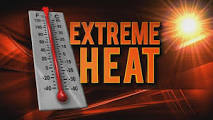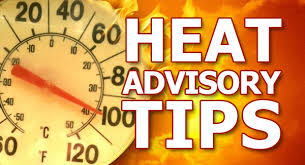As the mercury rises this summer, follow these important heat advisory safety tips so you can stay safe and cool this summer. Everyone can be affected by excessive heat. However, there are certain populations who are more sensitive to extreme heat, these include: the elderly, people with chronic health conditions, low income families, infants and children, outside workers, and athletes.
To keep safe during a heat advisory, following these steps:
- Drink plenty of water throughout the day – don’t wait until you are thirsty
- Avoid alcohol and sugary drinks
- Wear loose, light-colored clothing and a large brimmed hat
- Wear and reapply sunscreen as directed on the package
- Schedule activities early in the morning or later in the evening – avoid midday
- Use your air-conditioner if you have one
- If you don’t have air-conditioning, find a local cool-down shelter in your area
- Don’t use your stove or oven to cook, as it will make you and your home hotter
- Take cool showers or baths to cool down
- Check on friends and neighbors; have someone do the same for you
- Know the signs and treatment for heat-related illness
3 types of heat-related illness: Heat Cramps, Heat Exhaustion, Heat Stroke
Knowing the warning signs and how to treat each one will help keep you and your family safe this summer.
Heat Cramps
Heat cramps may be the first sign of heat-related illness and may lead to heat exhaustion or heat stroke.
Symptoms:
- Painful muscle cramps and spasms usually in legs and abdomen
- Heavy sweating
First Aid:
- Apply firm pressure on cramping muscles or gently massage to relieve spasm.
- Give sips of water unless the person complains of nausea, then stop giving water.
Heat Exhaustion
Symptoms:
- Heavy sweating
- Weakness
- Cool, pale, clammy skin
- Fast weak pulse
- Muscle cramps
- Dizziness
- Nausea, vomiting
- Fainting
First Aid:
- Move person to cool place
- Lay person down and loosen clothing
- Apply cool, wet clothes to as much of the body as possible
- Fan or move victim to air-conditioned room
- Offer sips of water
- If person vomits more than once, seek medical attention
Heat Stroke
Symptoms:
- Altered mental state
- Shallow breathing, confusion, throbbing headache, nausea, dizziness
- Body temp above 103 degrees
- Hot red, dry or moist skin
- Rapid and strong pulse
- Fainting or lose of consciousness
First Aid:
- Heat stroke is a severe medical emergency. Call 911 and get victim to hospital immediately, as it can be fatal
- Move victim to cool, air-conditioned environment
- Reduce body temperature with cool clothes or bath
- Use a fan to cool the person, only if heat index temperatures are lower than high 90’s (if heat index is higher than high 90’s, using a fan can make a person hotter)
- Do NOT give fluids









